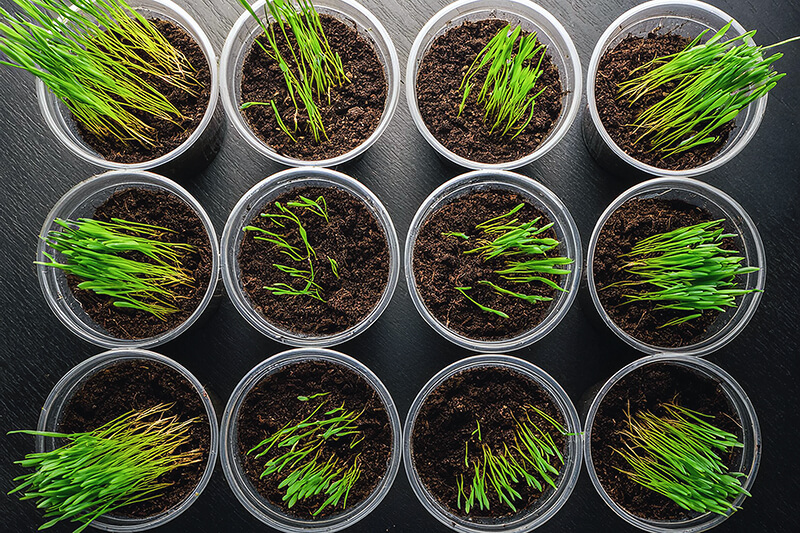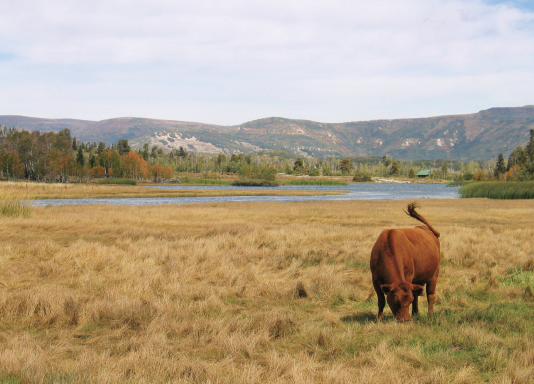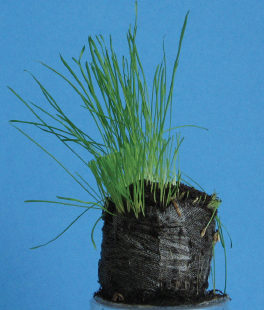At Home on the Range (Grades 6-8)
Students investigate rangelands by growing their own grass to represent a beef or sheep ranch.

Background
Lesson Activities
Recommended Companion Resources
Credits
Author
Debra Spielmaker | Utah Agriculture in the Classroom
Standards
Texas Content Area Standards
-
Principles of Agriculture, Food, and Natural Resources: 130.2.c.1
The student demonstrates professional standards/employability skills as required by business and industry. The student is expected to:
- Principles of Agriculture, Food, and Natural Resources: 130.2.c.1.B: apply competencies related to resources, information, interpersonal skills, problem solving, critical thinking, and systems of operation in agriculture, food, and natural resources.
-
Principles of Agriculture, Food, and Natural Resources: 130.2.c.4
The student explains the historical, current, and future significance of the agriculture, food, and natural resources industry. The student is expected to:
- Principles of Agriculture, Food, and Natural Resources: 130.2.c.4.B: analyze the scope of agriculture, food, and natural resources and its effect upon society.
- Principles of Agriculture, Food, and Natural Resources: 130.2.c.4.C: evaluate significant historical and current agriculture, food, and natural resources developments.
- Principles of Agriculture, Food, and Natural Resources: 130.2.c.4.F: compare and contrast issues impacting agriculture, food, and natural resources such as biotechnology, employment, safety, environment, and animal welfare issues.
-
Principles of Agriculture, Food, and Natural Resources: 130.2.c.6
The student demonstrates appropriate personal and communication skills. The student is expected to:
- Principles of Agriculture, Food, and Natural Resources: 130.2.c.6.A: demonstrate written and oral communication skills appropriate for formal and informal situations such as prepared and extemporaneous presentations.
- Principles of Agriculture, Food, and Natural Resources: 130.2.c.6.B: demonstrate effective listening skills appropriate for formal and informal situations.
-
Principles of Agriculture, Food, and Natural Resources: 130.2.c.7
The student applies appropriate research methods to agriculture, food, and natural resources topics. The student is expected to:
- Principles of Agriculture, Food, and Natural Resources: 130.2.c.7.B: use a variety of resources for research and development.
- Principles of Agriculture, Food, and Natural Resources: 130.2.c.7.C: describe scientific methods of research.
- Principles of Agricultures, Food, and Natural Resources: 130.2.c.7.A: discuss major research and developments in the fields of agriculture, food, and natural resources.
-
Principles of Agriculture, Food, and Natural Resources: 130.2.c.10
The student develops technical knowledge and skills related to soil systems. The student is expected to:
- Principles of Agriculture, Food, and Natural Resources: 130.2.c.10.A: identify the components and properties of soils.
-
Principles of Agriculture, Food, and Natural Resources: 130.2.c.11
The student develops technical knowledge and skills related to plant systems. The student is expected to:
- Principles of Agriculture, Food, and Natural Resources: 130.2.c.11.A: describe the structure and functions of plant parts.
- Principles of Agriculture, Food, and Natural Resources: 130.2.c.11.B: discuss and apply plant germination, growth, and development.
- Principles of Agriculture, Food, and Natural Resources: 130.2.c.11.D: identify plants of importance to agriculture, food, and natural resources
- Principles of Agriculture, Food, and Natural Resources: 130.2.c.11.E: use tools, equipment, and personal protective equipment common to plant systems.
-
Principles of Agriculture, Food, and Natural Resources: 130.2.c.15
The student explains the relationship between agriculture, food, and natural resources and the environment. The student is expected to:
- Principles of Agriculture, Food, and Natural Resources: 130.2.c.15.A: determine the effects of agriculture, food, and natural resources upon safety, health, and the environment.
- Principles of Agriculture, Food, and Natural Resources: 130.2.c.15.B: identify regulations relating to safety, health, and environmental systems in agriculture, food, and natural resources.
- Principles of Agriculture, Food, and Natural Resources: 130.2.c.15.C: identify and design methods to maintain and improve safety, health, and environmental systems in agriculture, food, and natural resources.
-
ELA: 7.110.23.b.5
Comprehension skills: listening, speaking, reading, writing, and thinking using multiple texts. The student uses metacognitive skills to both develop and deepen comprehension of increasingly complex texts.
- ELA: 7.110.23.b.5.H: synthesize information to create new understanding
- ELA: 7.110.23.b.5.G: evaluate details read to determine key ideas
-
Social Studies: 6.113.18.c.19
Social studies skills. The student applies critical-thinking skills to organize and use information acquired through established research methodologies from a variety of valid sources, including technology. The student is expected to:
- Social Studies: 6.113.18.c.19.C: organize and interpret information from outlines, reports, databases, and visuals, including graphs, charts, timelines, and maps
-
Science: 6.112.26.b.1
Scientific and engineering practices. The student, for at least 40% of instructional time, asks questions, identifies problems, and plans and safely conducts classroom, laboratory, and field investigations to answer questions, explain phenomena, or design solutions using appropriate tools and models. The student is expected to:
- Science: 6.112.26.b.1.A: ask questions and define problems based on observations or information from text, phenomena, models, or investigations
- Science: 6.112.26.b.1.B: use scientific practices to plan and conduct descriptive, comparative, and experimental investigations and use engineering practices to design solutions to problems
- Science: 6.112.26.b.1.E: collect quantitative data using the International System of Units (SI) and qualitative data as evidence;
- Science: 6.112.26.b.1.F: construct appropriate tables, graphs, maps, and charts using repeated trials and means to organize data;
-
Social Studies: 6.113.18.c.22
Social studies skills. The student uses problem-solving and decision-making skills, working independently and with others. The student is expected to:
- Social Studies: 6.113.18.c.22.B: use problem-solving and decision-making processes to identify a problem, gather information, list and consider options, consider advantages and disadvantages, choose and implement a solution, and evaluate the effectiveness of the solution
-
Science: 6.112.26.b.2
Scientific and engineering practices. The student analyzes and interprets data to derive meaning, identify features and patterns, and discover relationships or correlations to develop evidence-based arguments or evaluate designs. The student is expected to:
- Science: 6.112.26.b.2.C: use mathematical calculations to assess quantitative relationships in data; and
-
Science: 6.112.26.b.5
Recurring themes and concepts. The student understands that recurring themes and concepts provide a framework for making connections across disciplines. The student is expected to:
- Science: 6.112.26.b.5.C: analyze how differences in scale, proportion, or quantity affect a system's structure or performance;
-
Social Studies: 7.113.19.c.20
Social studies skills. The student applies critical-thinking skills to organize and use information acquired through established research methodologies from a variety of valid sources, including technology. The student is expected to:
- Social Studies: 7.113.19.c.20.C: organize and interpret information from outlines, reports, databases, and visuals, including graphs, charts, timelines, and maps
-
Social Studies: 7.113.19.c.23
Social studies skills. The student uses problem-solving and decision-making skills, working independently and with others. The student is expected to:
- Social Studies: 7.113.19.c.23.B: use problem-solving and decision-making processes to identify a problem, gather information, list and consider options, consider advantages and disadvantages, choose and implement a solution, and evaluate the effectiveness of the solution
-
Science: 6.112.26.b.10
Earth and space. The student understands the rock cycle and the structure of Earth. The student is expected to:
- Science: 6.112.26.b.10.C: describe how metamorphic, igneous, and sedimentary rocks form and change through geologic processes in the rock cycle.
-
Science: 6.112.26.b.11
Earth and space. The student understands how resources are managed. The student is expected to:
- Science: 6.112.26.b.11.A: research and describe why resource management is important in reducing global energy poverty, malnutrition, and air and water pollution; and
- Science: 6.112.26.b.11.B: explain how conservation, increased efficiency, and technology can help manage air, water, soil, and energy resources.
-
Social Studies: 8.113.20.c.29
Social studies skills. The student applies critical-thinking skills to organize and use information acquired through established research methodologies from a variety of valid sources, including technology. The student is expected to:
- Social Studies: 8.113.20.c.29.C: organize and interpret information from outlines, reports, databases, and visuals, including graphs, charts, timelines, and maps
-
Social Studies: 8.113.20.c.31
Social studies skills. The student uses problem-solving and decision-making skills, working independently and with others. The student is expected to:
- Social Studies: 8.113.20.c.31.B: use problem-solving and decision-making processes to identify a problem, gather information, list and consider options, consider advantages and disadvantages, choose and implement a solution, and evaluate the effectiveness of the solution
-
Science: 7.112.27.b.1
Scientific and engineering practices. The student, for at least 40% of instructional time, asks questions, identifies problems, and plans and safely conducts classroom, laboratory, and field investigations to answer questions, explain phenomena, or design solutions using appropriate tools and models. The student is expected to:
- Science: 7.112.27.b.1.A: ask questions and define problems based on observations or information from text, phenomena, models, or investigations;
- Science: 7.112.27.b.1.B: use scientific practices to plan and conduct descriptive, comparative, and experimental investigations and use engineering practices to design solutions to problems;
- Science: 7.112.27.b.1.E: collect quantitative data using the International System of Units (SI) and qualitative data as evidence;
- Science: 7.112.27.b.1.F: construct appropriate tables, graphs, maps, and charts using repeated trials and means to organize data
-
Science: 7.112.27.b.2
Scientific and engineering practices. The student analyzes and interprets data to derive meaning, identify features and patterns, and discover relationships or correlations to develop evidence-based arguments or evaluate designs. The student is expected to:
- Science: 7.112.27.b.2.C: use mathematical calculations to assess quantitative relationships in data; and
-
Science: 7.112.27.b.5
Recurring themes and concepts. The student understands that recurring themes and concepts provide a framework for making connections across disciplines. The student is expected to:
- Science: 7.112.27.b.5.A: identify and apply patterns to understand and connect scientific phenomena or to design solutions;
-
Science: 7.112.27.b.12
Organisms and environments. The student understands that ecosystems are dependent upon the cycling of matter and the flow of energy. The student is expected to:
- Science: 7.112.27.b.12.A: diagram the flow of energy within trophic levels and describe how the available energy decreases in successive trophic levels in energy pyramids; and
- Science: 7.112.27.b.12.B: describe how ecosystems are sustained by the continuous flow of energy and the recycling of matter and nutrients within the biosphere.
-
Science: 7.112.27.b.13
Organisms and environments. The student knows how systems are organized and function to support the health of an organism and how traits are inherited. The student is expected to:
- Science: 7.112.27.b.13.B: describe the hierarchical organization of cells, tissues, organs, and organ systems within plants and animals;
-
Science: 8.112.28.b.1
Scientific and engineering practices. The student, for at least 40% of instructional time, asks questions, identifies problems, and plans and safely conducts classroom, laboratory, and field investigations to answer questions, explain phenomena, or design solutions using appropriate tools and models. The student is expected to:
- Science: 8.112.28.b.1.A: ask questions and define problems based on observations or information from text, phenomena, models, or investigations;
- Science: 8.112.28.b.1.B: use scientific practices to plan and conduct descriptive, comparative, and experimental investigations and use engineering practices to design solutions to problems;
- Science: 8.112.28.b.1.E: collect quantitative data using the International System of Units (SI) and qualitative data as evidence;
- Science: 8.112.28.b.1.F: construct appropriate tables, graphs, maps, and charts using repeated trials and means to organize data;
-
Science: 8.112.28.b.2
Scientific and engineering practices. The student analyzes and interprets data to derive meaning, identify features and patterns, and discover relationships or correlations to develop evidence-based arguments or evaluate designs. The student is expected to:
- Science: 8.112.28.b.2.C: use mathematical calculations to assess quantitative relationships in data; and
-
Science: 8.112.28.b.5
Recurring themes and concepts. The student understands that recurring themes and concepts provide a framework for making connections across disciplines. The student is expected to:
- Science: 8.112.28.b.5.A: identify and apply patterns to understand and connect scientific phenomena or to design solutions;
-
Science: 8.112.28.b.11
Earth and space. The student knows that natural events and human activity can impact global climate. The student is expected to:
- Science: 8.112.28.b.11.A: use scientific evidence to describe how natural events, including volcanic eruptions, meteor impacts, abrupt changes in ocean currents, and the release and absorption of greenhouse gases influence climate;
- Science: 8.112.28.b.11.B: use scientific evidence to describe how human activities, including the release of greenhouse gases, deforestation, and urbanization, can influence climate; and
- Science: 8.112.28.b.11.C: describe the carbon cycle.
-
Science: 8.112.28.b.12
Organisms and environments. The student understands stability and change in populations and ecosystems. The student is expected to:
- Science: 8.112.28.b.12.A: explain how disruptions such as population changes, natural disasters, and human intervention impact the transfer of energy in food webs in ecosystems;
- Science: 8.112.28.b.12.B: describe how primary and secondary ecological succession affect populations and species diversity after ecosystems are disrupted by natural events or human activity; and
- Science: 8.112.28.b.12.C: describe how biodiversity contributes to the stability and sustainability of an ecosystem and the health of the organisms within the ecosystem.
-
Science: 7.112.27.b.11
Earth and space. The student understands how human activity can impact the hydrosphere. The student is expected to:
- Science: 7.112.27.b.11.A: analyze the beneficial and harmful influences of human activity on groundwater and surface water in a watershed; and
-
ELA: 6.110.22.b.3
Developing and sustaining foundational language skills: listening, speaking, reading, writing, and thinking--fluency. The student reads grade-level text with fluency and comprehension. The student is expected to adjust fluency when reading grade-level text based on the reading purpose
- ELA: 6.110.22.b.3: Developing and sustaining foundational language skills: listening, speaking, reading, writing, and thinking--fluency. The student reads grade-level text with fluency and comprehension. The student is expected to adjust fluency when reading grade-level text based on the reading purpose
-
ELA: 6.110.22.b.5
Comprehension skills: listening, speaking, reading, writing, and thinking using multiple texts. The student uses metacognitive skills to both develop and deepen comprehension of increasingly complex texts. The student is expected to:
- ELA: 6.110.22.b.5.G: evaluate details read to determine key ideas
- ELA: 6.110.22.b.5.H: synthesize information to create new understanding
-
ELA: 6.110.22.b.6
Response skills: listening, speaking, reading, writing, and thinking using multiple texts. The student responds to an increasingly challenging variety of sources that are read, heard, or viewed. The student is expected to:
- ELA: 6.110.22.b.6.F: respond using newly acquired vocabulary as appropriate
-
ELA: 7.110.23.b.3
Developing and sustaining foundational language skills: listening, speaking, reading, writing, and thinking--fluency. The student reads grade-level text with fluency and comprehension. The student is expected to adjust fluency when reading grade-level text based on the reading purpose.
- ELA: 7.110.23.b.3: Developing and sustaining foundational language skills: listening, speaking, reading, writing, and thinking--fluency. The student reads grade-level text with fluency and comprehension. The student is expected to adjust fluency when reading grade-level text based on the reading purpose
-
ELA: 7.110.23.b.6
Response skills: listening, speaking, reading, writing, and thinking using multiple texts. The student responds to an increasingly challenging variety of sources that are read, heard, or viewed. The student is expected to:
- ELA: 7.110.23.b.6.F: respond using newly acquired vocabulary as appropriate
-
ELA: 8.110.24.b.3
Developing and sustaining foundational language skills: listening, speaking, reading, writing, and thinking--fluency. The student reads grade-level text with fluency and comprehension. The student is expected to adjust fluency when reading grade-level text based on the reading purpose.
- ELA: 8.110.24.b.3: Developing and sustaining foundational language skills: listening, speaking, reading, writing, and thinking--fluency. The student reads grade-level text with fluency and comprehension. The student is expected to adjust fluency when reading grade-level text based on the reading purpose
-
ELA: 8.110.24.b.5
Comprehension skills: listening, speaking, reading, writing, and thinking using multiple texts. The student uses metacognitive skills to both develop and deepen comprehension of increasingly complex texts. The student is expected to:
- ELA: 8.110.24.b.5.G: evaluate details read to determine key ideas
- ELA: 8.110.24.b.5.H: synthesize information to create new understanding
-
ELA: 8.110.24.b.6
Response skills: listening, speaking, reading, writing, and thinking using multiple texts. The student responds to an increasingly challenging variety of sources that are read, heard, or viewed. The student is expected to:
- ELA: 8.110.24.b.6.F: respond using newly acquired vocabulary as appropriate
-
Math: 6.111.26.b.1
Mathematical process standards. The student uses mathematical processes to acquire and demonstrate mathematical understanding. The student is expected to:
- Math: 6.111.26.b.1.A: apply mathematics to problems arising in everyday life, society, and the workplace
- Math: 6.111.26.b.1.C: select tools, including real objects, manipulatives, paper and pencil, and technology as appropriate, and techniques, including mental math, estimation, and number sense as appropriate, to solve problems
-
Math: 6.111.26.b.3
Number and operations. The student applies mathematical process standards to represent addition, subtraction, multiplication, and division while solving problems and justifying solutions. The student is expected to:
- Math: 6.111.26.b.3.D: add, subtract, multiply, and divide integers fluently
- Math: 6.111.26.b.3.E: multiply and divide positive rational numbers fluently
-
Math: 7.111.27.b.1
Mathematical process standards. The student uses mathematical processes to acquire and demonstrate mathematical understanding. The student is expected to:
- Math: 7.111.27.b.1.A: apply mathematics to problems arising in everyday life, society, and the workplace
- Math: 7.111.27.b.1.B: use a problem-solving model that incorporates analyzing given information, formulating a plan or strategy, determining a solution, justifying the solution, and evaluating the problem-solving process and the reasonableness of the solution
-
Math: 7.111.27.b.3
Number and operations. The student applies mathematical process standards to add, subtract, multiply, and divide while solving problems and justifying solutions. The student is expected to:
- Math: 7.111.27.b.3.A: add, subtract, multiply, and divide rational numbers fluently
- Math: 7.111.27.b.3.B: apply and extend previous understandings of operations to solve problems using addition, subtraction, multiplication, and division of rational numbers
-
Math: 8.111.28.b.1
Mathematical process standards. The student uses mathematical processes to acquire and demonstrate mathematical understanding. The student is expected to:
- Math: 8.111.28.b.1.A: apply mathematics to problems arising in everyday life, society, and the workplace
- Math: 8.111.28.b.1.B: use a problem-solving model that incorporates analyzing given information, formulating a plan or strategy, determining a solution, justifying the solution, and evaluating the problem-solving process and the reasonableness of the solution

